By: debbie lynn elias
One of my Top Twenty films of all time is Tomas Alfredson’s LET THE RIGHT ONE IN. Written by John Lindqvist based on this best selling novel by the same name, this is the story of Oskar, a wimpish, bullied boy with a slightly curious and twisted dark side, who explores and finds the innocence of love with Eli, a mesmerizing young girl who often smells funny, can’t stand the sun or the light and who, as Oskar comes to learn, is actually a creature of the night. Can his love overlook Eli’s thirst for blood? A spellbinding story and exquisitely executed film set in the Stockholm suburb of Blackeberg in 1982, as I was interviewing Anderson two years ago just prior to the film’s U.S. release, an English-speaking Hollywood adaptation was already in the works. Given the excellence of the story and the critical claim and audience reception of Alfredson’s film already overseas, it was easy to see why someone would jump on a remake. But, the question arises, how do you improve on perfection.

Enter writer/director Matt Reeves who describes how LET THE RIGHT ONE IN became LET ME IN under his guiding eye and pen. When he was first approached, “It was daunting. But it got more daunting as it went along because when I first got involved, initially they brought it to me almost a year before the film had even come out. So I had never heard of it. They showed it to me. My first response upon seeing it was that I told them I didn’t really know that they should remake it because it was just fantastic. I think it’s amazing. I really connect to it on a personal level. It’s wonderful. It scares me that they would want to remake that. And then I read the novel and it also blew me away. It got into all kinds of detail about Oskar’s childhood. I really connected to it because it was about Lindqvist’s childhood growing up in the 80’s. And I grew up at the same time in the United States. I suddenly started thinking maybe the way to do it is to translate to an American context that I remember from growing up so the idea wouldn’t be in any way trying to step on the toes of Alfredson’s film which is a masterpiece. Just do our own version of the story. But that was all before the film came out. I communicated with Lindqvist and he was very supportive. I felt a pressure and responsibility to honor that story and to still find a way to make it personal. But then after I finished the first draft, the Swedish film came out to tremendous acclaim and then it got even more daunting. I thought, ‘Oh my gosh. What have I embarked on.’” What Reeves embarked on was LET ME IN, a “labor of love” that gave him the “best chance of doing something that was worthwhile.”
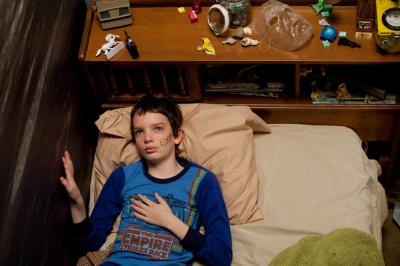
Abby is your average blond, blue-eyed 12 year old girl. Moving into a small apartment complex in a small, gritty New Mexico town, she immediately catches the eye of her neighbor, Owen, himself about the same age. Owen is taken with Abby’s mysterious residency beginning with her moving in late one snowy winter night. Two men and a trunk came are with her. Through his telescope (which he uses to spy on all of the neighbors) he sees that the first thing the new neighbors due is cover up the windows with cardboard and duct tape. He finds it interesting and curious. As for Owen, he is a loner. A bit odd, he is bullied at school with his only solace coming from spying on neighbors, playing video games at the arcade and now, wondering about this girl.
Hanging out in the common area of the apartment complex at night, Owen continually stares at the covered windows of the new girl, until the moment comes when a waifish, barefoot girl who “never gets cold” even now in the dead of winter and who smells a bit funny, joins him on the snow covered jungle gym picnic table one night.
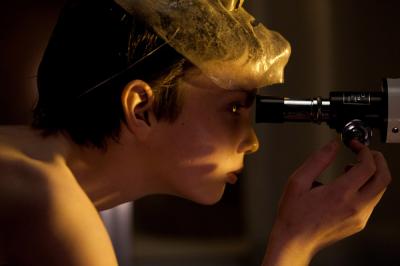
Inquisitive about each other, with much trepidation, a tentative bond begins to form between the two, a bond that quickly blossoms into puppy love with Owen drawing courage from Abby and Abby finding friendship in her own lonely world. But while Owen and Abby grow closer, strange things are happening in the once quiet town. Unexplained grisly murders. A man who self-inflicts burns to his face and body, a neighbor who bursts into flames after an attack in the courtyard. And Abby, well, it turns out Abby is a vampire.
Chloe Moretz is mesmerizing as Abby. I have had the pleasure of watching Chloe grow over the past several years from her stellar performance in Lori Petty’s “The Poker House” to this year’s “Kick-Ass” and now, LET ME IN. To put it plainly, Moretz just gets better and better. She brings a great innocence and vulnerability to Abby that makes you just adore and worry about her. The tentative shyness she exudes is charming b ut then she can turn on a dime into a feral creature of the night.
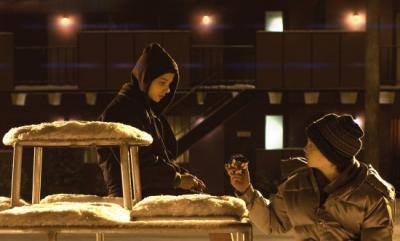
Kodi Smit-McPhee is outstanding as the tortured Owen. With a wide-eyed look of wonder and nerdiness, he brings a great innocence and purity to Owen, balancing elements of good and evil and eliciting very dark, dark feelings stemming from Owen’s sense of helplessness. Never feeling forced, the emotion he brings is very natural and human. (In the book, the Oskar/Owen character is actually fascinated with revenge, murder and serial killers.)
And then put Moretz and Smit-McPhee together and the chemistry is simply enchanting. Young love, puppy love…..very very sweet. It is a joy to watch the two of them interact and just feed off each other.
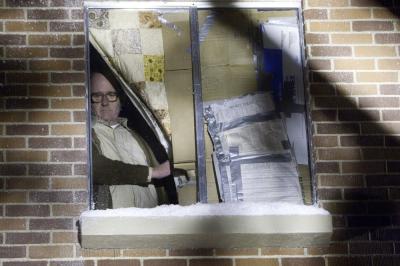
Oscar nominee Richard Jenkins turns in a standout performance as “Father”, the elder man who travels and cares for Abby. Bringing a nuanced level of emotion to the character and to his scenes with Moretz, the result is intriguing, raising questions as to who he really is. Notable is one scene where the entire history of Abby and Father is captured in a split second when he puts his hand on her cheek and she has her hand on his arm. Very powerful and telling. Doing his own stunt work, Jenkins amazed even himself with dragging bodies through snow, hauling them up in pulley like fashion, falling down hills and into small ravines.
Pivotal is Elias Koteas’ turn as an unnamed police detective investigating the sudden surge of death in the area. It is through his eyes that the story is set and the tale begins to unfold. Quiet and unyielding, Koteas brings tacit depth to the film.
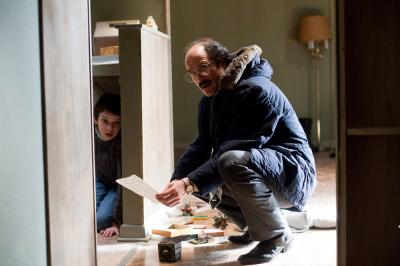
Reeves has indeed achieved his goal of doing something worthwhile. Approaching this project with an eye towards “what can I do to try to personalize it and contextualize it in a world that I understood”, Reeves retained both the beauty and horror of Lindqvist’s book which “has so much detail about growing up in Sweden at that time.” But then he took the universal themes that Lindqvist addressed with such specificity for a Swedish boy, and brought those same kind of details to the film for a boy in the US during the same time period.
Putting aside my own admiration and awe for LET THE RIGHT ONE IN and addressing LET ME IN as a stand alone film, LET ME IN is a superb thriller from a psychological fright factor. Interesting, intense with some truly frightening and creepy moments. Special effects are minimal but when used, they are amazing, particularly when Moretz turns into an ugly distorted “creature of the night”. Emotions are multi-textural and layered with an endearing curious and unjaded innocence and naivete. Reeves also provides a great scene after one of Abby’s vampiric attacks leaving her covered in blood. In a moment of tenderness, she kisses Owen. He is immobilized but you see intrigue in his eyes. A chilling site that sparks questions and leaves you spellbound.
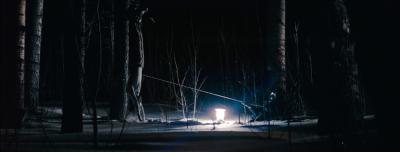
However, despite the overall excellence, there are some problems, not the least of which is the worst “fake” snow I have ever seen in my life. Much of the film takes place in the apartment courtyard with Owen and Abby and involves them sitting on the jungle gym/picnic table. I believe that is the worst example of fake snow on a flat surface that I have ever seen. It didn’t even sink when they sat on it and the sprinkled fake snow was such poor quality you could see it was plastic. Also problematic is that for several nighttime scenes where it is supposed to be frigid, no warm breath visible in the cold night air during conversation between characters. The blood also appears too red with a poor consistency. Someone didn’t pay attention to Alfred Hitchcock 101 on blood.
Although not a big fan of the jaundiced yellow patina in much of the film, overall, cinematographer Greig Fraser creates an interesting visual pallette and then compliments it with impeccable framing.

I truly appreciate that Reeves and co-writer John Lindqvist stayed so true to the original story and the visual conceptualization, with even the dialogue basically the same as in the book and in LET THE RIGHT ONE IN. Very minimalistic. Very deliberate. Yes, LET ME IN has an “American” feel to it, but as any fan of the original film or book will note, the events are essentially the same, with a few omissions and changes, the emotional intensity of the characters and the performances are still there, the beauty of this “innocent” romance and the innocence of a child who is so open and accepting to something such as vampires without being fearful or jaded. But what does disappoint me are the minutiae of technical details such as the sound, visible warm air against the cold. When sitting on the edge of your seat wondering what is going to happen, those little things just escalate the tension and fear and they were missing here.
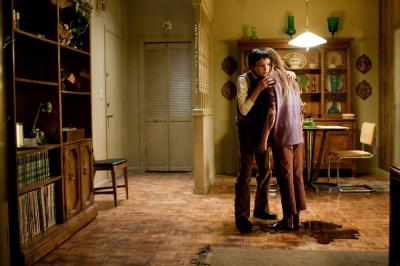
Now, having said the above, and in light of my admiration for LET THE RIGHT ONE IN, let me say this: I slightly prefer Alfredson’s version to Reeves’ LET ME IN. In the original, imagery and cinematography is more vivid and intense. The white of the snow, the inky liquid black of the night. The red blood splattered against the white or black. More visually shocking and stimulating. True colors, rich colors (or rich absence of color). Much more effective when dealing with vampires and fear. The fact that they filmed in Sweden in the dead of winter obviously helped as well given that it added to the psychological intensity of the film. You heard every footstep or drop of a snowflake crunch on the snow. There was no sound enhancement in the original and the elements of nature – particularly the snap of a twig, the crunch of fresh snow or ice-covered snow adds additional auditory sensory elements of fear to the film. That is lacking in here. The acting performances of Moretz and Smit-McPhee are equally as outstanding as those of Lina Leandersson and Kare Hadebrandt, although Moretz is a bit more of a standout. Noticeable is that in the original our little vampire Eli is the one with black hair and Oskar is the blonde blue-eyed little Swede. I think is one of the reasons that Moretz is superior here as Abby is because of her innocent look and the blond blue-eyed sweetness. There’s not a hint of darkness to her (other than very dirty feet). You would never expect her to be a vampire.
What I truly appreciate is that Reeves and John Lindqvist (who also wrote the novel and the original) stayed so true to the original story and the visual conceptualization. even the dialogue is basically the same. Very minimalistic. Yes, LET ME IN has an “American” feel to it, but the events are essentially the same with a few omissions and changes, the emotional intensity of the characters and the performances are still there. the beauty of this “innocent” romance and the innocence of a child who is so open and accepting to something such as vampires without being fearful or jaded. But what does disappoint me are the minutiae of technical details such as the sound, visible warm air against the cold. When sitting on the edge of your seat wondering what is going to happen, those little things just escalate the tension and fear and they were missing here.
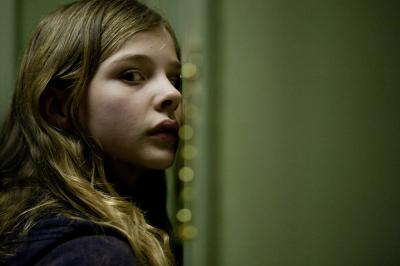
As comes as no surprise, Oscar winner Michael Giacchino has composed a beautiful score that serves the film well. Adding depth and compliment to the composition is Giacchino’s use of the celeste which provides a bell-like tonal quality to the work. Coming to the project as a long-time friend of Reeves, it has long been their dream to work together and LET ME IN was their first opportunity. “He is a tremendously gifted composer. He understands mixtures of tones and has an ability to mine all these different aspects of the movies that he works on. He understands a lot about story and character and it comes through in the way that he writes.” Making Giacchino the perfect composer for LET ME IN was also his ability to “find a way to reflect the kind of vulnerability and childlike atmosphere. The celeste came from that. The idea of bringing in voices of a young boys’ choir was all Gianochio. On the one hand he really does mine the darkness and there’s really some kind of eerie, disturbing music. There’s also really tender music and that I knew he would be able to do.” Interestingly, Giacchino is terrified of horror movies to the point that he will cover his eyes or turn away at the scary or gory parts.
Does Reeves create fright? Yes. Scare you? Yes. Intrigue you? Yes, yes. Weave a web that is spellbinding and enthralling? Absolutely. Leave you wanting more? Yes!! So much so that I look forward to a sequel to see how this boy and vampire travel and survive in the world and how their love will survive.
This weekend, make sure to get yourself in to the nearest theatre for LET ME IN.
Abby – Chloe Moretz
Owen – Kodi Smit-McPhee
The Father – Richard Jenkins
The Policeman – Elias Koteas
Directed by Matt Reeves. Written by Matt Reeves and John Ajvide Lindqvist based on Lindqvist’s screenplay and novel Lat den Ratte Komma In (Let the Right One In)












